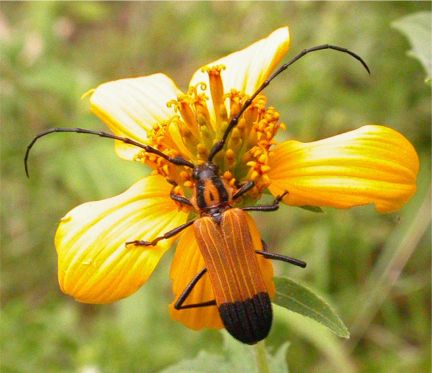|
|
Return to Texas Entomology - Compiled by Mike Quinn
|
|
(on underside of flower)

|
Range:
Hidalgo & Starr Counties, Texas; ne Mexico (Coahuila, Nuevo León, San Luis Potosí, Tamaulipas). (Monné & Hovore, 2005)
Adult Activity:
September to December (Hovore et al. 1987), but most common mid-October to early November (pers. com. Dan Heffern).
Larval Host: Unknown (Hovore et al. 1987)
Behavior:
(Hovore et al. (1987) reports taking this species in abundance, often with Mannophorus laetus, from several members of the Asteraceae, including Viguiera, Helianthus, and Verbesina.
Similar Species: There are five species of Parevander, but only P. hovorei reaches the United States (Monné & Hovore, 2005)
Etymology: Parevander hovorei Giesbert, 1984
par, -i (L). Equal
ven, =a, -o (L). A vein (?)
der, -o (G). The neck; the hide
hovorei - patronym honoring Frank T. Hovore (1945-2006)
Biography: Edmund F. Giesbert (1931 - 1999)
Arnett, R.H., Jr., M.C. Thomas, P. E. Skelley & J.H. Frank. (editors). 2002. American Beetles, Volume II: Polyphaga: Scarabaeoidea through Curculionoidea. CRC Press. 861 pp.
Borror, D.J. 1960. Dictionary of Word Roots and Combining Forms. National Press Books, Palo Alto. 134 pp.
Giesbert, E.F. & R.L. Penrose. 1984. Two new purpuricenine longhorns (Coleoptera: Cerambycidae) from the Tamaulipan biotic province. The Coleopterists Bulletin, 38(1): 59-65, 3 figs.
Hovore, F.T. & E.F. Giesbert. 1976. Notes on the ecology and distribution of western Cerambycidae. The Coleopterists Bulletin, 30(4):349-360.
Hovore, F.T., R.L. Penrose & R.W. Neck. 1987. The Cerambycidae, or longhorned beetles, of southern Texas: a faunal survey (Coleoptera). Proceedings of the California Academy of Sciences, 44(13): 283-334, 20 figs.
Monné, M.A. & F.T. Hovore. 2005. Electronic Checklist of the Cerambycidae of the Western Hemisphere. 393 pp.
01 Dec 2008 © Mike Quinn / mike.quinn@tpwd.state.tx.us / Texas Entomology / Texas Beetle Information